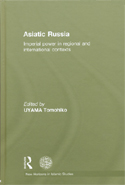 |
Edited by UYAMA Tomohiko |
 |
Edited by UYAMA Tomohiko |
| Contributors |
ix
|
|
| Preface |
xii
|
|
| Maps |
xiv
|
| Introduction: Asiatic Russia as a space for asymmetric interaction |
Uyama Tomohiko |
1
|
| Russia’s eastern expansion: its “mission” and the Tatars’ intermediary role |
11
|
|
| 1 The Russian Empire’s civilizing mission in the eighteenth century: A comparative perspective |
Ricarda Vulpius |
13
|
| 2 Tatarskaia Kargala in Russia’s eastern policies |
Hamamoto Mami |
32
|
| 3 The Russian Empire and the intermediary role of Tatars in Kazakhstan: the politics of cooperation and rejection | Gulmira Sultangalieva |
52
|
| Taming space and people: institutions and demography |
81
|
|
| 4 Intra-bureaucratic debate on the institution of Russian governors-general in the mid-nineteenth century |
Matsuzato Kimitaka |
83
|
| 5 Colonization and “Russification” in the imperial geography of Asiatic Russia: from the nineteenth to the early twentieth centuries |
Anatolii Remnev |
102
|
| 6 Empire and demography in Turkestan: numbers and the politics of counting |
Sergei Abashin |
129
|
| Russian power projected beyond its borders |
151
|
|
| 7 Russo-Chinese trade through Central Asia: regulations and reality |
Noda Jin |
153
|
| 8 Muslim networks, imperial power, and the local politics of Qajar Iran |
Robert D. Crews |
174
|
| 9 Sunni-Shi‘i relations in the Russian protectorate of Bukhara, as perceived by the local ‘ulama |
Kimura Satoru |
189
|
| 10 The open and secret diplomacy of Tsarist and Soviet Russia in Tibet: the role of Agvan Dorzhiev (1912–1925) |
Nikolay Tsyrempilov |
216
|
| Asiatic Russia as a space for national movements |
235
|
|
| 11 Muslim political activity in Russian Turkestan, 1905–1916 |
Salavat Iskhakov |
237
|
| 12 The economics of Muslim cultural reform: money, power, and Muslim communities in late imperial Russia | James H. Meyer |
252
|
| 13 The Alash Orda’s Relations with Siberia, the Urals and Turkestan: the Kazakh national movement and the Russian imperial legacy |
Uyama Tomohiko |
271
|
| Index |
288
|